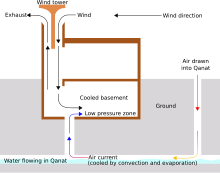
Back تبريد المباني السلبي Arabic Climatització passiva Catalan Passive Kühlung German خنککننده منفعل Persian Refroidissement passif French Pasivno hlađenje Croatian Pendinginan pasif ID Resfriamento passivo Portuguese Pasif soğutma Turkish 無動力冷卻 Chinese

Passive cooling is a building design approach that focuses on heat gain control and heat dissipation in a building in order to improve the indoor thermal comfort with low or no energy consumption.[1][2] This approach works either by preventing heat from entering the interior (heat gain prevention) or by removing heat from the building (natural cooling).[3]
Natural cooling utilizes on-site energy, available from the natural environment, combined with the architectural design of building components (e.g. building envelope), rather than mechanical systems to dissipate heat.[4] Therefore, natural cooling depends not only on the architectural design of the building but on how the site's natural resources are used as heat sinks (i.e. everything that absorbs or dissipates heat). Examples of on-site heat sinks are the upper atmosphere (night sky), the outdoor air (wind), and the earth/soil.
Passive cooling is an important tool for design of buildings for climate change adaptation – reducing dependency on energy-intensive air conditioning in warming environments.[5][6]
- ^ Santamouris, M.; Asimakoupolos, D. (1996). Passive cooling of buildings (1st ed.). London: James & James (Science Publishers) Ltd. ISBN 978-1-873936-47-4.
- ^ Leo Samuel, D.G.; Shiva Nagendra, S.M.; Maiya, M.P. (August 2013). "Passive alternatives to mechanical air conditioning of building: A review". Building and Environment. 66: 54–64. Bibcode:2013BuEnv..66...54S. doi:10.1016/j.buildenv.2013.04.016.
- ^ Limb M.J., 1998: "Passive Cooling Technologies for office buildings. An Annotated Bibliography". Air Infiltration and Ventilation Centre (AIVC), 1998
- ^ Niles, Philip; Kenneth, Haggard (1980). Passive Solar Handbook. California Energy Resources Conservation. ASIN B001UYRTMM.
- ^ "Cooling: The hidden threat for climate change and sustainable goals". phys.org. Retrieved 2021-09-18.
- ^ Ford, Brian (September 2001). "Passive downdraught evaporative cooling: principles and practice". Arq: Architectural Research Quarterly. 5 (3): 271–280. doi:10.1017/S1359135501001312. ISSN 1474-0516. S2CID 110209529.
© MMXXIII Rich X Search. We shall prevail. All rights reserved. Rich X Search